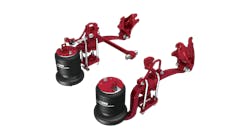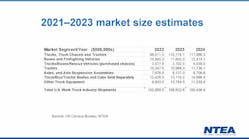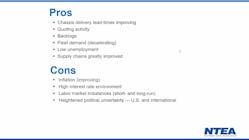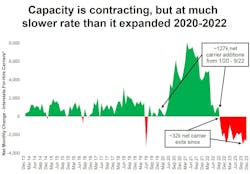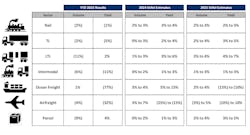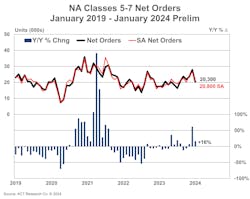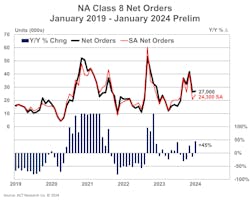As FTR Chairman Eric Starks typically opens his market forecast presentations: “Why do people buy trailers?”
And the audience typically responds with the question’s correct answer: “To move freight.”
But there hasn’t been a lot typical about the freight and corresponding transportation equipment markets for the last several years. The good news: The pandemic disruption and recovery have largely run their course, and traditional market cycles seem to be falling into place. The bad news: The freight cycle bottomed out in 2023 and the rebound remains on the horizon; that means that the heavy-duty trailer and truck markets can expect a down year in 2024.
There’s a silver lining even to that bad news, however, as the anticipated 2024 slip follows several exceptional years, and the trough will likely be well above the lows of past cycles, economists and market analysts agree.
Rate recovery coming
Record-high freight rates in 2021-22 drove the spike in equipment demand, as fleets tend to prefer buying new trucks and trailers to paying taxes on piles of cash. Last year, however, rates collapsed as freight demand slipped and there was an oversupply of trucks after new entrants flooded the market during the boom.
So the freight transportation sector can look forward to “better days” in 2024, but that’s mainly because “better” isn’t much of a stretch compared to 2023, explained the sector analysts at Stifel in a recent presentation.
“Freight volumes actually weren’t that bad in that absolute context [in 2023], better than in 2018 and better than the pre-pandemic freight pullback in 2019, of course,” Stifel Director Bruce Chan said. “But compared to the boom years of 2022 and 2021, the comps were incredibly difficult.”
Additionally, 2023 got off to an unexpectedly bad start that prompted a lot of carriers to develop a more realistic outlook. Chan attributed the macroeconomic slip to “residual destocking” that had begun late in 2022. Inflation and high diesel prices added to the pain.
But a “fairly modest but pronounced firming” in freight volume marked a return to seasonality later in 2023—and an easing in inflation and fuel prices point to the beginnings of a margins recovery. Still, ongoing “mixed signals” have prompted the Stifel analysts to take a “more conservative” view of freight volume growth in 2024.
“Inventories in the last cycle peaked out in early 2023 and, for the most part, destocking is complete. Of course, we’re still waiting for some clear signals that a restocking has begun—and that’s been a little bit harder to come by,” Chan said. “Given some of the indicators that we’re seeing on the consumer side of things, and given many shippers have trepidation about the direction of the economy, those inventories will probably be a little bit slower to recover.”
On the manufacturing side of the macro outlook, growth has been below the historical average. Still, the ISM index finished the year above forecasts as the industrial slowdown has stretched into the “longer side” of historical periods of contraction.
“The takeaways are, first, that 2023 was a very unpredictable year—we had a lot of head fakes about when a bona fide bottoming would take place: Is this really the bottom? Or is this another head fake?” Chan said. “We, and certainly others, have called the bottom a few times, and we do think it’s here. But we’re mindful that a deterioration in underlying demand would be a real driver of another leg down in the market.”
Still, as Chan pointed out, trucking is approaching the end of a typical market trough. However, the market still faces overcapacity, which Chan attributed to the “elevated retained earnings” banked by many independent truckers during the boom.
“By and large, the survival of a lot of these small players has surprised us—so it could just be a matter of time. As this trough wears on longer and longer, the likelihood of capacity exits really starts to grow—and that should be a big inflection for spot prices, even in a flat volume environment,” he said. “A lot of the small carriers are contending with some elevated costs—and that’s really across the board with inflation. The recent move down in diesel prices might provide some temporary reprieve on operating costs, but any additional increase in fuel or other costs would accelerate those exits.”
Keys to keep an eye on
In summary, 2024 is likely more of a “transition to better days” than a full-blown market rebound, as the presentation characterized the year ahead. Stifel’s critical points for the trucking segment included:
- Spot rates should return to a “seasonally normal cadence,” but fleets and truck drivers shouldn’t “expect fireworks” this summer. Positives heading into 2024 include:
- Van spot rates exhibited signs of normal seasonality, rising moderately before the holidays;
- Import TEUs finished higher than expected in the final four months of 2023; and
- Confirmation of the Fed’s pause in interest rate hikes and a “potentially firming macro backdrop.” Stifel forecasts van spot rates to grow in the low single digits in 2024 compared to last year, with a typical spring weakness, midsummer spike, and late summer cooling ahead of the holiday peak.
- For spot rates to turn materially higher and buoy contract rates, further capacity exits will be necessary ahead of any demand improvement. Demand will remain weak through the year’s first half, given the seasonally weaker time frame and “generally sluggish but stable” conditions. Again, spot rates will depend on supply, and diesel prices will be a crucial indicator for capacity changes. Ultimately, the historic spread between spot rates and contracts will take longer to converge during this cycle.
- Contract rates have formed “a new floor” around pre-COVID cycle peak levels and would react quickly to a spot rate recovery—but are most likely to “persist sideways” for a bit longer. Therefore, the first half of 2024, particularly the first quarter, will be “a tougher period.” But once demand snaps back, the cycle could be extended by challenges to capacity growth, such as high interest rates and employment growth in labor-competitive sectors like infrastructure and construction.
- Reshoring activity continues “picking up steam,” driven by supply chain “de-risking,” regulatory efforts, and relative cost advantages—a positive for truckload freight.
- The brokerage business faces “a little bit of a longer runway” towards recovery, as a recovery for asset-based trucking has to come first.
- For the intermodal segment, the question is always whether the business can take market share from truckload. But lower truckload rates make the “trade down” in service with intermodal “less desirable.” However, as the rails begin to invest in improved service, intermodal becomes a more attractive option. Stifel anticipates a single-digit recovery in intermodal volume, compared to “a fairly low bar” set in 2023.
Equipment outlook: Trailers
As carrier profits and equipment demand wait for the cycle to turn upward, 2024 is more about “hoping and coping” than continued boom times for the trailer market, according to the January issue of ACT Research’s State of the Industry: U.S. Trailers report.
“With 35% of the year’s orders historically booked in Q4, the quarter’s seasonal factors run roughshod on the nominal data,” said Jennifer McNealy, director–CV market research and publications at ACT Research. “Dry van orders contracted 87% y/y, with reefers down 56% and flats 75% lower compared to December 2022.”
Total cancellations increased to 1.7% of the backlog from November’s 0.9%, elevated for most segments and much higher for some, she added. Several markets were again above 1.0%, including dry vans at 1.3%, flats at 3.5%, medium lowbeds at 1.5%, and dumps at 1.3%. Both tank categories reported a spike in cancellations, both around 7% of the backlog. Recent oil price weakness may bear some culpability.
FTR reported similar year-end numbers for trailers, noting that the build number was the lowest since the beginning of 2021—but a drop in production after November is normal. Average monthly build is “still healthy” at more than 26,600 units.
“With orders coming in above production levels, backlogs in December rose somewhat, increasing by more than 3,000 units to more than 143,300 units in total,” said FTR’s Starks. “The fall in production and increase in backlogs resulted in an increase for the backlog-to-build ratio to 7.1 months. The ratio is slightly elevated due to the lower production levels in December and is above the historical average before 2020. A jump in the ratio is normal around the holidays, and the overall picture is still of an industry that is continuing its move towards a pre-pandemic level of stability.”
Publicly traded trailer and truck body manufacturer Wabash echoed the outlook, even as its earning report for the fourth quarter of 2023 capped a year that delivered annual records for sales, operating income, and earnings per share. (See Page 32 for more details.)
Read more: Trailer orders climb in August: ACT Research
While the financial performance forecast for Wabash this year is “a moderation” from 2023’s record performance, the freight market already is beginning “to heal and correct itself,” with measurable improvement for fleet customers “probably by midsummer”—assuming interest rates continue to moderate and that the status quo can be maintained from a “geopolitical” standpoint, Wabash President and CEO Brent Yeagy said in a conference call with investment analysts earlier this month. He’s even more optimistic about next year.
“The things that the U.S. economy is acting on sets us up for a much better 2025,” Yeagy said. “Can we see a significant demand difference in 2025? I believe that to be the case. I think you’ll see that robustness build throughout 2025, and I think it can be material. We are planning our business based off of that being the most probable outcome.”
Equipment outlook: Trucks
Despite the sluggish freight economy in 2023, over-the-road trucking fleets opened 2024 in a buying mood, according to the latest data from two leading commercial vehicle research firms.
FTR reported that the January Class 8 preliminary in North America came in at 26,400 units, up 2% from December and up 35% year-over-year. ACT Research’s preliminary data showed 27,000 orders, up 600 units from December and 45% year-over-year.
“Weak freight and carrier profitability fundamentals, and large carriers guiding to lower capex in 2024, would imply some pressure in the North American Class 8 market’s largest segment, U.S. tractor,” Kenny Vieth, ACT president and senior analyst, said. “While we do not yet have the underlying detail for January orders, Class 8 demand continuing at high levels at the start of 2024 suggests that over-the-road US truckers are still buying.”
Seasonal adjustments pushed ACT’s January numbers up 11% to a 12-month seasonally adjusted annual rate of 292,000. FTR’s 12-month figures total 259,000 Class 8 orders. The firm noted that the heavy-duty truck market has been picking up in recent months: Orders from the last three months would equate to a 354,000-unit annualized rate; the previous six months would be a 327,000-unit annualized rate.
“Build slots continue to be filled at a healthy rate,” FTR’s Starks said. “With January orders coming in at a rate that was comparable to the previous month, the market is still performing at a high level historically. It was a mixed market for OEMs this month, with some seeing increases and others seeing decreases in orders. Fleets continue to be willing to order new equipment despite uncertainty in the freight market. Order levels were above the historical average and above seasonal trends, although we still expect 2024 activity to reflect replacement demand.”
ACT also reported that seasonably adjusted North American Class 5 through Class 7 net orders increased this year from 20,300 units in December to 20,800 in January, according to ACT’s State of the Industry: Classes 5-8 Vehicles report.
“Unlike Class 8, medium-duty seasonality is modestly positive in January, boosting the seasonally adjusted order tally to 20,800 units, down 21% month-over-month from a tough best-month-of-2023 December comp.”
Indeed, medium-duty markets likewise can expect a return to more normal cycles as the supply chain challenges that hit Classes 2-6 for the past couple of years are being resolved, explained Steve Latin-Kasper, NTEA director of market data and research, during his recent presentation on the outlook for the work truck market in 2024.
“There was a period in time when there were still a fairly large number of chassis quarantined in parking lots around North America—and they have mostly moved off of those lots and into the upfit system at this point,” Latin-Kasper noted. “Supply chains have greatly improved. Having said that, there are still some obvious issues out there. But we expect that the supply chain and chassis availability to continue getting better as we go through 2024. And that will be especially true towards the end of the year, as the new chip plants start coming online here in the United States.”
Dealing with uncertainty
‘Disruption’ is a buzzword, especially among those who bill themselves as disruptors.
But for most manufacturers, suppliers, and distributors, there’s just the ebb and flow of business cycles. There’s no denying that the Covid pandemic and the recovery were, however, not historically normal. The circumstances were truly disruptive. And as Patrick Gaskins, SVP of Corcentric Fleet Solutions, contributed recently to FleetOwner.com, disruption leads to leads to uncertainty. Gaskins outlines three “significant uncertainties” to plan for in 2024:
Economic uncertainty: Even though 2023 ended with the financial markets having an unexpectedly strong finish, there are still concerns about 2024 for fleets and, therefore, equipment suppliers. As discussed broadly above, though the U.S. hasn’t seen a nationwide recession, a freight recession has put equipment OEMs “on the front line,” seeing reduced orders and shorter backlogs.
“The lack of freight puts pressure on ocean, air, and ground transportation companies that purchased additional ships, planes, and tractors for post-pandemic freight movement,” Gaskins writes. “Now, many are struggling just to keep afloat. Yellow Freight is just one example of a company misjudging the market. Consolidation and the elimination of capacity will pick up pace in 2024.”
Bottom line, per Gaskins: “Businesses must decide whether to plan for growth or go into survival mode.”
Supply chain uncertainty: Supply chains are still stressed, largely because manufacturing labor is difficult to find.
“You name it: truck bodies, RV manufacturers, truck and tractor OEMs, and construction, they are all pulling from the same labor pool,” Gaskins suggests.
And, globally, shipping has seen threats from two ongoing wars and a “massive” reduction in capacity at the Panama Canal due to low water levels. These factors are forcing shippers to reroute, adding “days and weeks” to product deliveries.
Asset-type uncertainty: Gaskins also notes that the EV boom “looks like a short-term bust.”
He points to a recent report from ATRI that calculated the power necessary to fuel the needs of a national electrified transport fleet would cost billions and is “almost a non-starter for the conversion.”
That includes California, which has been the champion for battery electric vehicles and zero emissions, he adds.
Then there’s the cost. BEV trucks are sticker-price expensive, plus the cost of reduced cargo-carrying capacity due to the weight and size of batteries. According to ATRI, more trucks will be needed, an additional 343 trucks for every 1,000 vehicles currently on the road.
Another downside for BEVs: The freeze that impacted so much of the northern U.S. early in the 2024 points to a reduction in driving range.
“For fleets, this is, again, very costly in terms of both revenue and time,” he writes. “Some states that were ready to follow California’s emissions standards are now starting to reevaluate where they stand regarding expectations vs. reality. This is good news for fleets since, with all the issues facing BEVs, fleet managers were being put in difficult positions when it comes to planning. Do they purchase a limited number of electric vehicles, work with a third-party provider to handle transportation in states with emissions mandates, or walk away from doing business in those same states?”
Conclusion on uncertainty: To succeed in uncertain times, fleets and their equipment providers must make “minor adjustments rather than sweeping changes,” Gaskins says. “I believe there is a future for BEVs; we just need to do much more work on an aging infrastructure. Until then, we need to focus on improving existing technologies and become more efficient in conducting business. Being more efficient means exploring all the alternatives to existing supply chains, educating our youth on the benefits of trade skills, and focusing on what we can control.”







